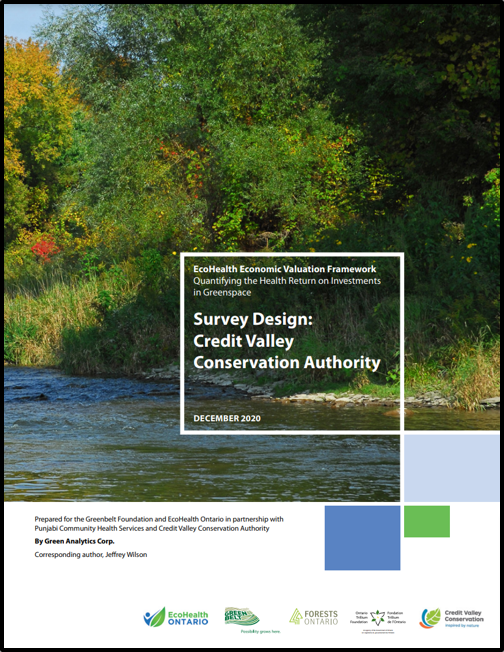NEW ARTICLE!
New Ontario Research Helps Us Estimate The Health Care
Savings From Urban Green Infrastructure
EcoHealth Economic Valuation Framework - Case Studies
Quantifying the Health Return on Investments in Greenspace
Three case studies were undertaken in 2019/2020 applying the ecohealth conceptual framework in order to understand the benefits which are accrued when using ecohealth practices. These included developing a survey and program which can be used with seniors in Peel Region to improve their life satisfaction and general well-being; a project to plant additional trees in order to increase the tree canopy in a Brampton neighbourbood to help adapt to impacts from heat and air pollution; and a parking lot transformation into an urban downtown park in Peterborough.
Each project identified the benefits they expected to achieve based on current research, and the pathways (or activities) that would help to achieve those benefits.
The case studies created business cases for developing and implementing ecohealth practices. The economic framework developed to support each study links greenspace investments to improvements in health and well-being resulting in, for example, health system savings, prevented lost productivity associated with poor health and illness, and reduced mortality.
The conceptual framework makes links between greenspace investments, health outcomes, and economic benefits to inform the decision-making process. The results provide analysts and decision-makers with information on the ecohealth benefits of potential greenspace investments when evaluating policies, programs and actions.
Assigning a monetary value to greenspace investments is challenging, given the difficulties in identifying quantifiable health outcomes attributed to a policy, program, or planning decision. These case studies demonstrate how it is possible to draw on current research evidence to estimate health outcomes and their associated cost savings associated in specific situations, and that this can be valuable information for decision makers. Relevant research is showcased in each case study.
Research shows:
Access to green space can be linked to higher levels of physical activity and associated physical health improvements.
Mental health improvements associated with spending time in nature.
Health improvements associated with reduced exposure to air pollution (specifically reduced respiratory symptoms and incidences of cardiovascular disease) and avoided health system costs and lost productivity associated with extreme heat.
The case studies included the following:
Case Study: Downtown Urban Park, Peterborough, Ontario
Case Study: Increasing Tree Canopy, Brampton, Ontario
Survey Design: Credit Valley Conservation
Peterborough
The ECOhealth economic framework applied to this case study in Peterborough, Ontario shows how the creation of a new urban park is linked to improvements in health and wellbeing. These improvement result in significant health system savings through prevented lost productivity associated with poor health and illness, and reduced mortality. The park will also increase life satisfaction for local communities. The combined value of these worth $4,240,000 annually meaning the health return on investment will pay back the development cost in 1.5 years
Brampton
The ECOhealth economic framework applied to this case study in Brampton, Ontario shows how two scenarios for urban tree canopy expansion are linked to improvements in health and wellbeing. These improvement result in health system savings through reduced exposure to extreme heat days, improved air quality and increased physical activity. The annual net benefits are estimated to be between $2.5 million and $3.2 million.
Punjabi Community Health Services and Credit Valley Conservation Authority
Punjabi Community Health Services in association with Credit Valley Conservation Authority has developed a mental health program with the goal to engage 200 seniors in nature-based programming. As part of the programming, seniors will have opportunities to engage in mindfulness exercises, yoga in the forest, games using elements of nature and natural materials, poetry, storytelling, singing, and dancing. These surveys are designed to capture the data necessary to populate the economic framework once large gatherings can be held.




